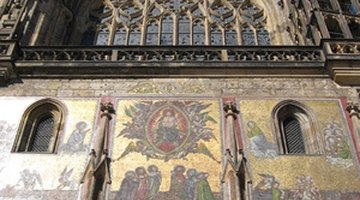Characteristics of Gothic Furniture
The Gothic Era can be traced back to Europe in the middle of the 12th century. However, it is by the middle of the 16th Century that Gothic furniture as we know it today became frequently used. Domestic Gothic furniture can be identified by key characteristics in its construction and design that make it unique and often sought after.
Wood

All types of Gothic furniture can be found largely in dark shades of wood, used to compliment the black and gray palette of the era. Oak was the most popular choice for the crafting of household furniture in Britain because it is strong and durable. Walnut was primarily used in pieces originating from France, while mahogany and rosewood were also imported and used in later designs.
Structure
Created at a dramatic time in history, Gothic furniture is considered the most visually striking of any era. The air of grandeur for house items comes from the influence of architecture on carpenters; the towering churches and cathedrals are proof today of the grandness of the era. Pointed arches on tall chairs and bookcases are a replica of the arches and towering columns found in cathedrals. The furniture itself is held together with mortise and tenon joints as nails and glue were not used during this time period. Square oak pegs used to hold joints together can be found in authentic Gothic furniture.
Carving
The most iconic characteristic of the Gothic era that is encapsulated in the furniture is the carvings. Religion heavily influenced the designs of furniture because the 12th Century was a period of heavy monasticism; the architecture of religious buildings was replicated in the home as people wanted the influence of the church in their family homes. Nature is also a theme that can be identified for the 12th Century craftsmanship; foliage adorned the sides of tables and chairs, while imaginary birds and animals are often found in the metal mountings on chest drawers. For pieces made in England, the Tudor Rose is often the focal point of carvings, and the Fleur-De-Lis was popular in French-made furniture.
Gargoyles
Like the outside of religious buildings constructed from the 12th to 16th century, Gothic furniture may often have mythical creatures carved into the woodwork. Dragons and gargoyles are particularly found on the ends of four-poster beds and down the sides of bookcases. Although they're considered evil creatures, they were etched onto furniture to act as guardians of the item they inhabit and therefore protect anyone using them.
Tapestry
Despite the Gothic palette predominantly dull in color, fabrics draped over furniture and cushions are often vibrant. Warm reds and golds are used, with the art of tapestry weaving giving it a luxurious texture to them.Benches in particular have fabrics draped over to add a bit of comfort to whoever wants to sit.
References
Resources
Photo Credits
- Gothic Cathedral image by Rumble_g from Fotolia.com
More Articles



